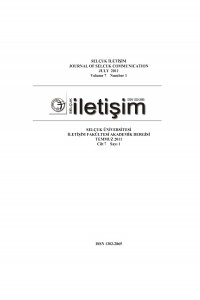YALNIZLIK VE TELEVİZYON KULLANIMI
Abstract
Yalnızlık hem bireysel hem de toplumsal bir fenomendir. Medya kullanımı ve televizyon izleme de yalnızlıkla baş etme stratejilerinden biridir. Bu yüzden yalnızlık ve televizyon kullanımı arasındaki bağlantıların ortaya çıkarılması önemlidir. Bu çalışmada, insanların yalnızlık seviyesine bağlı olarak hangi doyumları elde etmek amacıyla televizyon izlediği sorusuna cevap aranmıştır. Analiz sonuçları, yalnızlık düzeyi arttıkça televizyon izleme süresinin arttığını, yalnızların en çok televizyonda magazin programları, diziler ve sinema filmlerini izlediğini ortaya koymuştur. Yalnızlar arkadaşlık ve kaçış, zaman geçirme ve alışkanlık, eğlence ve sosyal etkileşim gereksinimlerini doyurmak için televizyon izlemektedirler. Ancak yalnızlık düzeyi arttıkça, televizyonda bilgilenme motivasyonuna verilen önem azalmaktadır.
References
- Cacioppo J T, Hawkley L C, Ernst J M, Burleson M, Berntson G G, Nouriani B ve Spiegel D (2006) Loneliness Within a Nomological Net: An Evolutionary Perspective, Journal of Research in Personality, 40, 1054-1085.
- Canary D J ve Spitzberg B H (1993) Loneliness and Media Gratifications, Communication Research, 20 (6) December, 800-821.
- Çakır V (2005) Bir Sosyal Etkinlik Olarak Eğlence ve Televizyon (Konya Örneği), S. Ü. Sosyal Bilimler Enstitüsü Derg, 13, 123-142.
- Finn S ve Gorr M B (1988) Social Isolation and Social Support as Correlates of Television Viewing Motivations, Communication Research, 15 (2), April, 135-158.
- Gerson A C ve Perlman D (1979) Loneliness and Expressive Communication, Journal of Abnormal Psychology, 88, 258-261.
- Gülnar B ve Balcı Ş (2010) Yeni Medya ve Kültürleşen Toplum, LiteraTürk Yayınları, İstanbul.
- Kim J ve Rubin A M (1997) The Variable Influence of Audience Activity on Media Effects, Communication Research, 24, 107-135.
- Koçak A (2001) Televizyon İzleyici Davranışları Televizyon İzleyicilerinin Tercihleri ve Doyumları Üzerine Teorik ve Uygulamalı Bir Çalışma, Doktora Tezi, S. Ü. Sos. Bil. Enst, Konya.
- Peplau L A ve Perlman D (1982) Perspectives on Loneliness, L A Peplau and D Perlman (eds) Loneliness: A Sourcebook of Current Theory, Research, and Therapy, New York, Wiley-Interscience, pp 1-18
- Peplau L A, Russell D ve Heim M (1979) The Experience of Loneliness. I H Frieze, D BarTal and J S Carroll (eds) New Approaches to Social Problems: Applications of Attribution Theory, San Francisco, CA, Jossey-Bass, pp 53-78
- Perlman D ve Peplau L A (1981) Toward a Social Psychology of Loneliness, R Gilmour and S Duck (eds), Personal Relationship: 3. Personal Relationships in Disorder, London, Academic Press, pp 32-56.
- Perlman D ve Peplau L A (1982) Theoretical Approaches to Loneliness, L A Peplau and D Perlman (eds), Loneliness: A Sourcebook of Current Theory, Research, and Therapy, New York: Wiley-Interscience, pp 123-134.
- Perlman D ve Peplau L A (1984) Loneliness Research: A Survey of Empirical Findings, L A Peplau and S Goldston (eds), Preventing the Harmful Consequences of Severe and Loneliness, U.S. Government Printing Office, pp 13-46
- Perlman D ve Peplau L A (1998) Loneliness, H Friedman (eds) Encyclopedia of Mental Health (Vol. 2), San Diego, CA: Academic Press. pp 571-581.
- Perse E M ve Rubin A M (1990) Chronic Loneliness and Television Use, Journal of Broadcesting & Elecktronic Media, 34 (1), Winter, 38-53.
- RTÜK (2009) Televizyon İzleme Eğilimleri Araştırması-2, Kamuoyu, Yayın Araştırmaları ve Ölçme Dairesi Başkanlığı.
- Rubenstein C ve Shaver P R (1982) The Experience of Loneliness, L A Peplau and D Perlman (eds), Loneliness: A Sourcebook of Current Theory, Research, and Therapy, New York, Wiley-Interscience, pp 206-223
- Rubenstein C, Shaver P ve Peplau L A (1979) Loneliness, Human Nature, February, 58-65.
- Rubin A M (1981) An Examination of Television Viewing Motivations, Communication Research, 8, 141-165.
- Rubin A M (1983) Television Uses and Gratifications: The Interactions of Viewing Patterns and Motivations, Journal of Broadcasting, Winter, 27 (1), 37-51.
- Rubin A M (1984) Ritualized and Instrumental Television Viewing, Journal of Communication, 34 (3), 67-77.
- Rubin A M, Perse E M ve Powell R A (1985) Loneliness, Parasocial Interaction, and Local Television News Viewing, Human Communication Research, 12 (2), 155-180
- Russell D (1996) UCLA Loneliness Scale (Versiyon 3): Reliability, Validity, and Factor Structure, Journal of Personalitiy Assessment, 66 (1), 20-40.
- Russell D, Peplau L A ve Cutrona C E (1980) The Revised UCLA Loneliness Scale: Concurrent and Discriminant Validity Evidence, Journal of Personality and Social Psychology, 39 (3), 472-480.
- Russell D, Peplau L A ve Ferguson M (1978) Developing a Measure of Loneliness, Journal of Personality Assessment, 42 (3), 290-294.
Details
| Primary Language | Turkish |
|---|---|
| Journal Section | Compilation Articles |
| Authors | |
| Publication Date | November 19, 2013 |
| Submission Date | December 4, 2013 |
| Published in Issue | Year 2011 Volume: 7 Issue: 1 |



